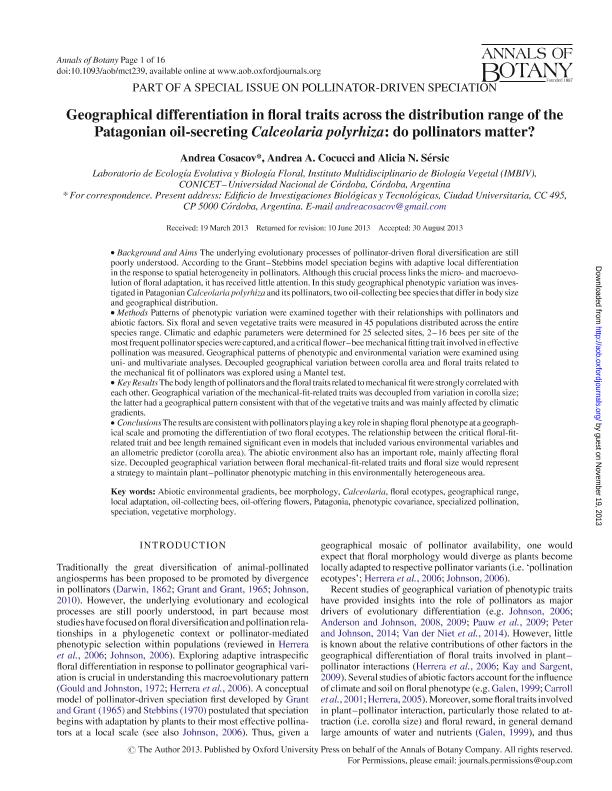Artículo
Geographical differentiation in floral traits across the distribution range of the Patagonian oil-secreting Calceolaria polyrhiza: Do pollinators matter?
Fecha de publicación:
09/2013
Editorial:
Oxford University Press
Revista:
Annals of Botany
ISSN:
0305-7364
Idioma:
Inglés
Tipo de recurso:
Artículo publicado
Clasificación temática:
Resumen
Background and Aims: The underlying evolutionary processes of pollinator-driven floral diversification are still poorly understood. According to Grant-Stebbins model speciation begins with adaptive local differentiation in response to spatial divergence in pollinators. Despite this crucial process links the micro- and macroevolution of floral adaptation, has received relatively poor attention. We studied geographical phenotypic variation of the Patagonian Calceolaria polyrhiza and its pollinators, two oil-collecting bee species that differ in body size and geographical distribution. Methods: We examined geographical pattern of phenotypic variation and its relationship with pollinators and abiotic factors. Six floral and seven vegetative traits were measured in 46 populations distributed across the entire species range. We selected 24 sites and retrieved their climatic and edaphic parameters; we captured 2-16 bees/site of the most frequent pollinator species and measured a critical flower-bee fitting trait involved in effective pollination. Geographical patterns of phenotypic variation and environmental variation were examined using uni- and multivariate analyses. Mantel permutation test was used to explore decoupled geographic variation between corolla area and fit-related floral traits. Key Results: Body length of pollinators and floral fit-related traits were strongly correlated with one another. Geographic variation of mechanical-fit related traits is decoupled from variation in corolla size. This latter floral trait has a geographical pattern consistent with that of vegetative traits and is mainly affected by climatic gradients. Conclusions: In this system pollinators play a key role in shaping floral phenotype at a geographical scale, promoting the differentiation of two floral ecotypes. The relationship between floral fit-related trait and bee length remained significant even in models that included various environmental variables and an allometric predictor (corolla area) one. The abiotic environment also has an important role, mainly affecting floral size. Decoupled geographical variation between fit-related traits and floral size is suggested to represent a strategy to maintain plant-pollinator phenotypic matching in this environmentally heterogeneous area.
Archivos asociados
Licencia
Identificadores
Colecciones
Articulos(IMBIV)
Articulos de INST.MULTIDISCIPL.DE BIOLOGIA VEGETAL (P)
Articulos de INST.MULTIDISCIPL.DE BIOLOGIA VEGETAL (P)
Citación
Cosacov Martinez, Andrea; Cocucci, Andrea Aristides; Sersic, Alicia Noemi; Geographical differentiation in floral traits across the distribution range of the Patagonian oil-secreting Calceolaria polyrhiza: Do pollinators matter?; Oxford University Press; Annals of Botany; 113; 2; 9-2013; 251-266
Compartir
Altmétricas




